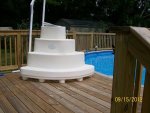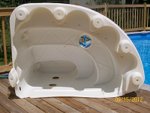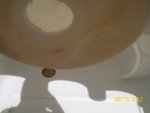My husband and I are new pool owners. We have a 27 foot round above ground pool, installed in May. Our pool has two large trees on either side of it, so getting leaves in the pool is an issue that we deal with. We've taken very good care of the pool and have done everything that we know to do to keep it clean. We have wedding cake steps, which is becoming a problem. We live on the gulf coast of Alabama. When hurricane Isaac went by we got a lot of leaves in our pool. We cleaned it out, but about a week later we got mustard algae. We shocked the pool three days in a room this week, with the last day being Wednesday. I vacuumed the pool to waste on Friday and we pulled the wedding cake steps out of the pool. We took the suction cups off from the bottom of the steps and clean them in bleach. We noticed that inside of the legs of the steps there are a few old leaves and it has specks of yellow in there. We cannot get into the legs to clean them because there is only about a one inch hole where the suction cups snap in place. I'm going to clean the steps with bleach, but after seeing what is inside the legs of the steps, I'm not sure we can actualy get rid of the mustard algae. I don't want to put the steps back in the pool, because I'm concerned the algae will just return. Any ideas on getting the steps algae free? We can brush the steps with bleach, but what about getting inside the legs that only have about a 1 inch opening? I don't see a way that we can get that cleaned out.
Thanks for any help you can give us.
Thanks for any help you can give us.







 Compare that to when we had our old pool and used the pool store and spent AT LEAST $75 a visit! We went to the pool store at least every other week but some weeks it was twice a week! :grrrr:
Compare that to when we had our old pool and used the pool store and spent AT LEAST $75 a visit! We went to the pool store at least every other week but some weeks it was twice a week! :grrrr: 